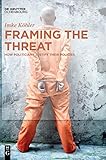Framing the Threat : How Politicians justify their Policies / Imke Köhler.
Material type: TextPublisher: München ; Wien : De Gruyter Oldenbourg, [2019]Copyright date: ©2019Description: 1 online resource (XIII, 279 p.)Content type:
TextPublisher: München ; Wien : De Gruyter Oldenbourg, [2019]Copyright date: ©2019Description: 1 online resource (XIII, 279 p.)Content type: - 9783110622140
- 9783110622355
- 9783110626056
- 320
- online - DeGruyter
- Issued also in print.
| Item type | Current library | Call number | URL | Status | Notes | Barcode | |
|---|---|---|---|---|---|---|---|
 eBook
eBook
|
Biblioteca "Angelicum" Pont. Univ. S.Tommaso d'Aquino Nuvola online | online - DeGruyter (Browse shelf(Opens below)) | Online access | Not for loan (Accesso limitato) | Accesso per gli utenti autorizzati / Access for authorized users | (dgr)9783110626056 |
Frontmatter -- With Thankfulness -- Contents -- List of Tables -- List of Abbreviations -- Part I: Research Design -- 1. Introduction -- Part II: Theoretical Framework and Methodology -- 2. Constructivism -- 3. Discourse Theory -- 4. Security Discourse -- 5. Mode of Conduct -- Part III: Empiricism -- 6. Bush’s Security Discourse and Policies -- 7. Obama’s Security Discourse and Policies -- Part IV: Conclusion -- 8. Findings and Implications -- References
restricted access online access with authorization star
http://purl.org/coar/access_right/c_16ec
There is great power in the use of words: words create most of what we consider to be real and true. Framing our words and narratives is thus a tool of power – but a power that also comes with limitations. This intriguing issue is the topic of Framing the Threat, an investigation of the relationship between language and security and of how discourse creates the scope of possibility for political action. In particular, the book scrutinizes and compares the security narratives of the former US presidents George W. Bush and Barack Obama. It shows how their framings of identity, i.e., of the American ‘self’ and the enemy ‘other’ facilitated a certain construction of threat that shaped the presidents’ detention and interrogation policies. By defining what was necessary in the name of national security, Bush’s narrative justified the operation of the detention center at Guantanamo Bay and rendered the mistreatment of detainees possible – a situation that would have otherwise been illegal. Bush’s framings therefore enabled legal limits to be pushed and made the violation of rules appear legitimate. Obama, in contrast, constructed a threat scenario that required an end to rule violations, and the closure of Guantanamo for security reasons. According to this narrative, a return to the rule of law was imperative if the American people were to be kept safe. However, Obama’s framing was continually challenged, and it was never able to dominate public discourse. Consequently, Framing the Threat argues Obama was unable to implement the policy changes he had announced.
Issued also in print.
Mode of access: Internet via World Wide Web.
In English.
Description based on online resource; title from PDF title page (publisher's Web site, viewed 25. Jun 2024)


